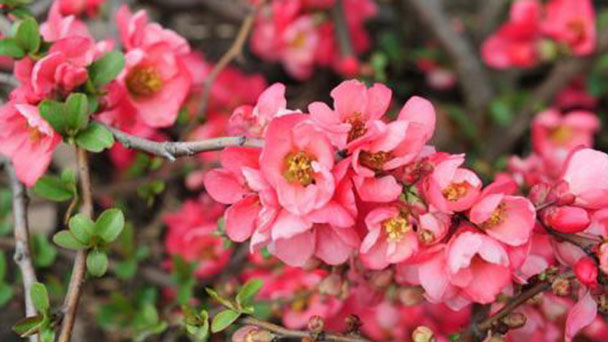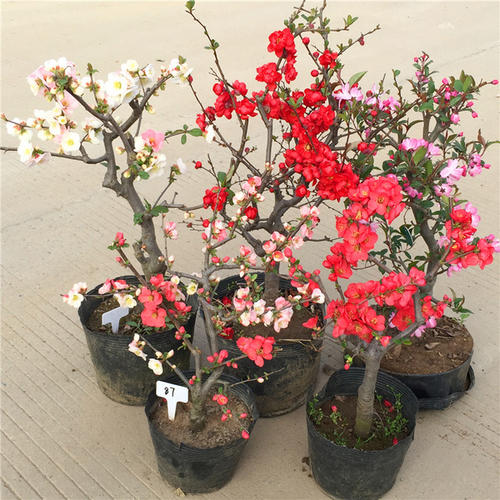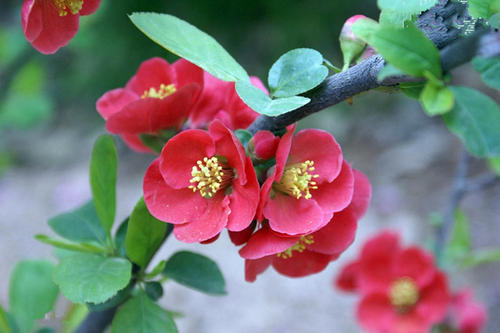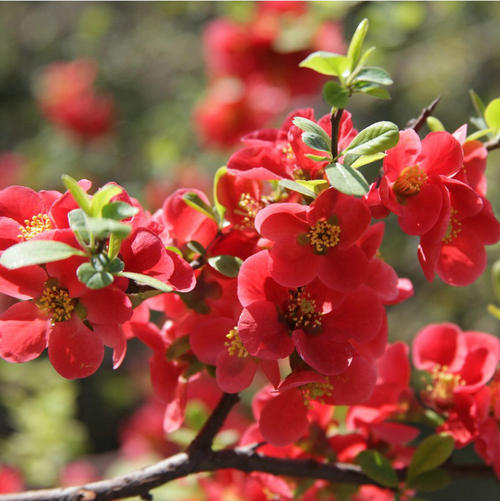Chaenomeles japonica ( Japanese quince) profile
Written by Maggie
Apr 01 2021

Chaenomeles japonica is also known as Japanese quince or Maule's quince. Chaenomeles japonica likes full sunlight, can also tolerate semi-shade and is slightly cold. Originally produced in Japan, it can now be found all over the Chinese mainland.
Chaenomeles japonica picture

Chaenomeles japonica info
| Botanical Name | Chaenomeles japonica |
| Common Names | Japanese quince, Maule's quince |
| Plant Type | Deciduous shrub |
| Sun | Full sun to part shade |
| Hardiness Zones | 5 to 9 |
| Flower color | Orange-scarlet |
| Native Area | Japan, South Korea |
| Mature size | 2.00 to 3.00 feet tall, 3.00 to 6.00 feet wide |
Morphological characteristics of Chaenomeles japonica
Branch
Chaenomeles japonica is a dwarf shrub, ca. 1 m tall, with widely spread branches and spines; Branchlets are coarse, cylindrical, villous when young, purplish red, two - year - old branches have warty protuberances, black-brown, glabrous; Winter buds are triangular-ovate, apex acute, glabrous, purplish-brown.
Leaf
Leaf-blade of Chaenomeles japonica is obovate, spatulate to broadly ovate, 3 -- 5 cm long, 2 -- 3 cm wide, apex obtuse, sparsely acute, base cuneate or broadly cuneate, margin obtuse, tooth tip incongruous, glabrous; Petiole ca. is 5 mm, glabrous; Stipules reniform with round teeth, 1 cm long, 1.5-2 cm wide.
Flowers
Flowers of chaenomeles japonica are clustered 3--5, pedicels short or nearly sessile, glabrous; Flowers are 2.5 --4 cm in diameter; Calyx tube is campanulate, glabrous outside; Sepals are ovate, thinly semicircular, 4--5 mm long, one and a half shorter than calyx parsimonious, apex acute or obtuse, margin inconspicuously serrated, glabrous outside, inner base with brown pubescent hairs and eyelashes; Petals are obovate or suborbicular; Base extending into short claws, ca. 2 cm long and 1.5 cm wide, brick red; Chaenomeles japonica has 40-60 stamens, about half of petal, 5 styles, basally connate, glabrous, stigmas capitate; There are inconspicuous divisions, about as long as the stamen.
Fruit
The fruit of Chaenomeles japonica is subglobose; 3--4 mm in diameter, yellow; Sepals fall off.
Ecological habits of Chaenomeles japonica
Chaenomeles japonica likes full sunlight and is tolerant to semi-shade. It does not grow well in saline-alkaline soil and clay soil.
Chaenomeles japonica likes to be wet but is afraid of waterlogging and rot.
The propagation of Chaenomeles japonica
The propagation of Chaenomeles japonica was mainly carried out by cutting in spring and autumn. The strong branches with a length of about 10 cm were cut and inserted in plain sand soil, watered to keep wet, placed in the shade, rooting in about 30 days, and then transplanted in the next spring. Grafting is also commonly used for reproduction, with cutting occurring in the spring and dependency occurring between April and July. Chaenomeles japonica can also be propagated by dividing plants, which can be carried out in spring and autumn and is easy to survive.
Disease control of Chaenomeles japonica
Chaenomeles japonica is easy to grow aphids. It can be sprayed by soaking tobacco leaves in water (available overnight) and avoided by dioate, otherwise it will cause fallen leaves. It can be destroyed by hand when domestic cultivation is small.

Species taxonomy of Chaenomeles japonica
Double disc
One in the world; Flowers two red, flowers up to 11CM in diameter, fruitless.
Long life; Flowers red, up to 9CM in diameter, results in striped, fruit 250g.
Longevity crown; Flowers flag red, 8CM in diameter, no fruit.
Silver longevity; The flowers are green and white, up to 8CM in diameter. The result is striped, medium.
Great riches and honor; Flowers orange-red, flowers 7CM in diameter, results in striped, fruit small.
(' Lu Baoshi ') -- alternate name: 'Silver longevity'
Flowers double, 3.5 -- 4.5cm in diameter; Petals 20 to 25, circular spoon-shaped; Flowers pale green at first, greenish-white or slightly yellowish at full bloom (RHS-CC 2D ~ 4D). According to the study, 'emerald stone' (Wang Jiaxiang,1998) and 'Yinshengshou' (Zhao Hongxia,2003) are the same variety. The former was published in 1998 and the latter in 2003. According to I.C.N.C.P., the earlier 'emerald stone' is chosen as the correct name.
Changshou Le
Flowers double, 3 -- 5cm in diam. Petals 15 to 20, circular, spoon-shaped, curled upward, with short claws; Corolla red with orange (RHS-CC 34A -- 34B).
(' Hong Baoshi ') -- Different name: 'Longevity Crown'
Flowers double, 4 -- 5cm in diam.Petals 18 to 25, circular spoon-shaped;Corolla bright red (RHS-CC 45A ~ 45B).According to the study, 'Ruby' (Wang Jiaxiang, 1998) and 'Changshou Guan' (Zhao Hongxia, 2003) are the same variety. The former was published in 1998 and the latter in 2003. According to I.C.N.C.P., the earlier 'Ruby' is chosen as the correct name.
(' Da Fugui ') -- alternate name: 'World One'
Flowers double, 5 -- 7cm in diam.Petals 28 to 35;Corolla red or orange-tinged (RHS-CC 41C).When the author published the variety, he proposed two names' Dafui Fugui 'and' World One '(Wang Jiaxiang, 1998), of which' Dafui Fugui 'has been widely used, according to the I.C.N.C.P.Stipulates that 'World One' is used as a synonym.
Distribution region of Chaenomeles japonica
Chaenomeles japonica is native to Japan and can be found in gardens throughout China. It has white flowers, variegated leaves and recumbent varieties.
Function and use of Chaenomeles japonica
The economic value
The oil rate of seed kernel oil is 35.99%, the oil yield is 30%, no peculiar smell, edible and can make soap. The fruit of Chaenomeles japonica is steamed and boiled into a candied fruit; It can also be used for medicinal purposes. Chaenomeles japonica has the effect of driving wind, regulating qi, relieving jin and relieving pain. It can also relieve alcohol and go to phlegm, and stew food and stop dysentery. Flowers can be used to make sugar sauces and are very tasty. The bark contains tannins, which can be used to produce tannin extracts. Wood is hard and can be used to make furniture and other appliances.
Landscape value
Chaenomeles japonica can beautify the park, family yard, street, square afforestation excellent ornamental tree species.

Latest Updated
- Benefits of Bugleweed - 7 Science-backed Health Benefits
- Bugleweed Dangers & Side Effects - Is It Poisonous?
- How to Plant Evergreen Trees - What You Should Know
- When to Plant Evergreens - Grow Guide for Evergreen Trees
- 12 Wonderful Evergreen Shrubs for Your Garden
- 12 Popular Evergreen Plants with Pictures for Beginners
- When And How To Prune A Lilac Bush Like a Pro
- How to Grow & Care for Lilac Vine (Hardenbergia Violacea)
- Japanese Lilac Tree (Syringa Reticulata) Care & Propagation Guide
- Shumard Oak Pros and Cons - What to Know
Popular Articles
- Winter maintenance of Antirrhinum Majus
- How to Grow Terminalia Mantaly Tree
- How to Grow and Care for Crossostephium Chinense
- How to grow Antirrhinum Majus in spring
- Peristeria Elata (Dove Orchid) Profile: Info & Care Guide
- Underwatered Snake Plant (Sansevieria Trifasciata) - Signs And How To Fix
- How to Care for Brazilian Jasmine Plant (Mandevilla Sanderi)
- How to Grow & Care for Graptopetalum Purple Delight in Summer
- Rosa Chinensis (China Rose): Plant Growing & Care Tips
- How to Care for Baby Sun Rose (Aptenia Cordifolia)